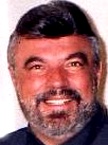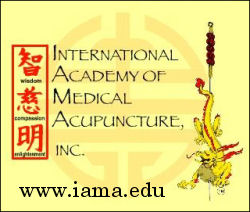Acupuncture & TCM Articles

Acupuncture Articles
by John A. Amaro L.Ac., Dipl.Ac.(NCCAOM), DC
 Dr. Amaro is an internationally known author, lecturer and practitioner beginning his practice of Acupuncture and Chiropractic in 1971. He has led 13 diplomatic Acupuncture study tours of The People's Republic of China escorting more than 500 doctors and practitioners. He has personally studied Acupuncture in nine separate Asian nations. Dr. Amaro is an internationally known author, lecturer and practitioner beginning his practice of Acupuncture and Chiropractic in 1971. He has led 13 diplomatic Acupuncture study tours of The People's Republic of China escorting more than 500 doctors and practitioners. He has personally studied Acupuncture in nine separate Asian nations.
He has received Certification in Acupuncture through the Columbia Institute of Chiropractic in 1973. This was one of the first Acupuncture postgraduate education programs for physicians in North America commencing in 1972.
He has been certified by the Waseda Acupuncture College in Tokyo, Japan in 1974 and graduated from the Chinese Medical Institute, Kowloon, China in 1976. He had previously taken postgraduate studies at the Tai Chung Medical School Taipei, China 1973.
The Kidney Meridian and the Hua Tuo Jiaji Points
John A. Amaro L.Ac., Dipl.Ac.(NCCAOM), DC
One of my absolute all time favorite acupuncture techniques, which I have used for many years with startling clinical response, involves the relationship of the anterior abdominal Kidney meridian to the Hua Tuo Jiaji points located over the lamina of the vertebrae.
Even though these two pathways are directly opposite of each other one being on the anterior and the other on the posterior body, it is this fact that makes it such a viable treatment option in a multitude of health conditions either visceral or musculoskeletal.
Without question, some of the most dynamic acupuncture points on the human body are known as the Huo Tuo jiaji points. These points may effectively treat virtually every known condition of the human system. They are extremely easy to locate and use. They respond not only to the acupuncture needle, but through any type of manual percussion such as a neurological reflex hammer, Wartenberg pin wheel, tuning fork, green and red laser, electro percussive therapy, Gua Sha, teishein (non invasive needle) or firm digital pressure. Any form of stimulation works absolute wonders in clinical practice.
These classic points are located just ½ human inch (a human inch is the distance across the widest part of the patients thumb) bilateral to the Du Mai (GV) (midline over the vertebral spinous process) bilateral from T1 through L5. Classically there are17 pair of points (34 total) attributed to Huo Tuo. These points have been extended by Asian scholars, both upward through the cervical spine and downward through the sacrum. Only the 17 bilateral points attributed to Huo Tuo carry his name as Huo Tuo Jiaji. The points in the cervical and sacrum are correctly and simply known as "jia"(lining) "ji" (spine).
The Hua Tuo points can virtually treat any somato-viscero or musculoskeletal condition in the body by simply going to a corresponding vertebral nerve root and treating the Hua Tuo points which are 0.5 tsun (inch) bilateral to the midline namely the Du Mo (GV) meridian. Classically the 17 pair of points attributed to Hua Tuo are from the 1st thoracic vertebrae extending to the 5th lumbar. When one recognizes the classic Huo Tuo Jijaji points to include the Jiaji points up through the cervical spine and down through the sacrum, the entire spinal sympathetic chain is affected through these points, which have no neurological limitations. Affecting these points at the vertebral nerve root level of an involved organ, structure or condition will produce favorable clinical response in the vast majority of maladies.
Likewise when one looks at the trajectory of the Kidney meridian, it is 0.5 inches bilateral to the anterior midline Ren Mo (CV) meridian. This flow is exactly the polar opposite of the Hua Tuo Jiaji points on the posterior. At KI21, which is directly opposite Ren 14 (one inch below the xiphoid) the meridian jogs dramatically lateral 2 tsun from the midline or 1.5 tsun lateral to the lower kidney meridian. Even though I utilize and respect the ancient description of the Kidney meridian and use it clinically as classically presented, for years I have in addition, extended the Kidney meridian straight up to one inch below the manubrium or just lateral to Ren 21. In essence what is accomplished is that it creates an anterior set of points, which work exactly the same way as the Hua Tuo points do on the back. However, one of the most startling discoveries is that if one were to continue the Kidney meridian superior past the Ren 21 level the meridian would traverse through the area of ST5 which is critical for anything in the head and neck, through ST4 at the corner of the mouth, continuing through LI20, BL1, BL2 on up and over the skull to meet up with the posterior polar opposite namely the Huo Tuo Jiaji points at BL10 next to the Atlas vertebrae. Thus, the new Kidney meridian extending superior past Ren 14 literally will connect with the Huo Tuo Jiaji points making a complete circuit through the body.
The importance here is that virtually any condition may be treated by simply applying the same principle to the Kidney (Anterior Hua Tuo points) as was applied at the level of the vertebral nerve root on the posterior.
Interestingly enough the entire spine may be treated through the anterior points as they are on the posterior. Look at the extended anterior point at the level of KI27 and Ren 21 as being attributed to the Atlas vertebrae and the classic KI11 0.5 tsun bilateral to Ren 2 at the symphysis pubes as the fifth lumbar vertebrae. This also extends to any and all somato-viscero problems by considering the Kidney meridian and its extension opposite of KI27 as a reflex directly to the sympathetic chain but on the anterior body. This is identical to the Hua Tuo Jiaji points.
It is important to realize in the "Lovett-Brother" concept that the L5 vertebrae has an intimate relationship to C1 whereas C2 has a relationship to L4, C3-L3 and continuing on until it meets in the center at T5-6. Therefore when one uses the polar opposite effect, CV (Ren) 2, 3, 4 are powerful points to affect the cervical spine especially C1, C2 and C3. This concept is also true that the upper Kidney meridian, which has been extended to be 0.5 inches bilateral to the midline opposite the upper sternum has a relationship to both the cervical spine as well as the lumbar spine.
In essence take a fresh look at the important Kidney meridian on the anterior trunk and in addition to allowing the meridian to jog 2 inches bilateral to the midline from the xiphoid to the manubrium, simply extend the Kidney meridian straight up so that the entire Kidney meridian is 0.5 inches bilateral to the Ren meridian exactly the polar opposite of the Hua Tuo points being 0.5 inches bilateral to the DU MO. It is imperative to treat KI27 where it is classically located two inches bilateral to the midline at the level of the first rib head in addition to the new point 0.5 tsun bilateral to the midline.
By incorporating this extremely simple procedure into your practice will produce some outlandish clinical results many have never seen before. To double your response, double your treatment meaning to generally stimulate both the front and back on the same visit. This does not need to be done with needles in fact a line laser for less than $300 produces fantastic response.
This procedure is too powerful not to incorporate into you practice immediately. To help in the understanding of this concept, you may request a graphic of this procedure by e-mailing me at dramaro@iama.edu .
Best wishes in utilizing what may become one of your favorite approaches to healing.
Extraordinary Acupuncture Point Locations and Indications
Point locations and indications for: Spinal Hua Tuo, Huatuojiaji, Yingtang, Yuyao, Jiachengjiang, Zengyin, Jingbi, Jianzhong, Weishang, Qipang, Weiba, Zigongxue, Erbaj, Bizhong, Heding, Xiding, Xiyan, Lanwei, Naoqing, Bafeng, Shimian, Linghou, Dannang, Sishencong, Erjian, Yiming, Biyan, Bitong, Zengyin, Anmian, Baxie, Yatong, Luozhen, Zhongquan, Sifeng, Shixuan, Wuming, Yaoyan, Shiqizhui, Yaoqi
|
